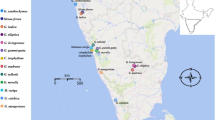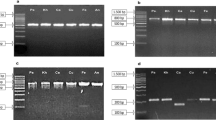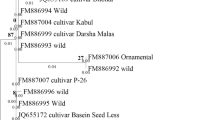Abstract
With the rapid growth of the fruit industry worldwide, it is important to assess adulteration to ensure the authenticity and the safety of fruit products. The DNA barcoding approach offers a quick and accurate way of identifying and authenticating species. In this study, we developed reference DNA barcodes (rbcL, ITS2, and trnH-psbA) for 70 cultivated and wild tropical fruit species, representing 43 genera and 26 families. In terms of species recoverability, rbcL has a greater recoverability (100%) than ITS2 (95.7%) and trnH-psbA (88.6%). We evaluated the performance of these barcodes in species discrimination using similarity BLAST, phylogenetic tree, and barcoding gap analyses. The efficiency of rbcL, ITS2, and trnH-psbA in discriminating species was 80%, 100%, and 93.6%, respectively. We employed a multigene-tiered approach for species identification, with the rbcL region used for primary differentiation and ITS2 or trnH-psbA used for secondary differentiation. The two-locus barcodes rbcL + ITS2 and rbcL + trnH-psbA demonstrated robustness, achieving species discrimination rates of 100% and 94.3% respectively. Beyond the conventional species identification method based on plant morphology, the developed reference barcodes will aid the fruit agroindustry and trade, by making fruit-based product authentication possible.






Similar content being viewed by others
Data availability
All data generated in this study are available within the paper and also as supplementary information.
References
Anerao J, Jha V, Shaikh N, Shivalkar A, Nityanand A, Sawant D, Rao GR, Mangaonkar K, Deodhar M, Desai N (2021) DNA barcoding of important fruit tree species of agronomic interest in the genus Garcinia L. from the Western Ghats. Genet Resour Crop Evol 68(8):3161–3177
Barcaccia G, Lucchin M, Cassandro M (2015) DNA barcoding as a molecular tool to track down mislabeling and food piracy. Diversity 8(1):2
CBOL Plant Working Group (2009) A DNA barcode for land plants. Proc Natl Acad Sci USA 106:12794–12797
Chen S, Yao H, Han J, Liu C, Song J, Shi L, Zhu Y, Ma X, Gao T, Pang X, Luo K, Li Y, Li X, Jia X, Lin Y, Leon C (2010) Validation of the ITS2 region as a novel DNA barcode for identifying medicinal plant species. PLoS ONE 5:e8613
China Plant BOL Group, Li DZ, Gao LM, Li HT, Wang H, Ge XJ, Liu JQ, Chen ZD, Zhou SL, Chen SL, Yang JB (2011) Comparative analysis of a large dataset indicates that internal transcribed spacer (ITS) should be incorporated into the core barcode for seed plants. Proc Natl Acad Sci USA 49:19641–19646
Dasenaki ME, Thomaidis NS (2019) Quality and authenticity control of fruit juices - a review. Molecules 24(6):1014
de Groot GA, During HJ, Maas JW, Schneider H, Vogel JC, Erkens RH (2011) Use of rbcL and trnL-F as a two-locus DNA barcode for identification of NW-European ferns: an ecological perspective. PLoS ONE 6(1):e16371
de Vere N, Rich TC, Ford CR, Trinder SA, Long C, Moore CW, Satterthwaite D, Davies H, Allainguillaume J, Ronca S, Tatarinova T (2012) DNA barcoding the native flowering plants and conifers of Wales. PLoS ONE 7(6):e37945
Duan H, Wang W, Zeng Y, Guo M, Zhou Y (2019) The screening and identification of DNA barcode sequences for Rehmannia. Sci Rep 9(1):1–12
FAO (2022) Major tropical fruits statistical compendium 2021. Rome
Faria MA, Magalhães A, Nunes ME, Oliveira MB (2013) High resolution melting of trnL amplicons in fruit juices authentication. Food Control 33(1):136–141
Fay MF, Swensen SM, Chase MW (1997) Taxonomic affinities of Medusagyne oppositifolia (Medusagynaceae). Kew Bull 52:111–120
Ferri G, Corradini B, Ferrari F, Santunione AL, Palazzoli F, Alu M (2015) Forensic botany II, DNA barcode for land plants: which markers after the international agreement? Forensic Sci Int: Genet 15:131–136
Fitmawati F, Hayati I, Sofiyanti N (2016) Using ITS as a molecular marker for Mangifera species identification in Central Sumatra. Biodiversitas 17(2):653–656
Hayamizu K, Ishii Y, Kaneko I, Shen M, Okuhara Y, Shigematsu N, Tomi H, Furuse M, Yoshino G, Shimasaki H (2003) Effects of Garcinia cambogia (Hydroxycitric Acid) on visceral fat accumulation: a double-blind, randomized, placebo-controlled trial. Curr Ther Res Clin Exp 64(8):551–567
Hebert PD, Cywinska A, Ball SL, DeWaard JR (2003) Biological identifications through DNA barcodes. Proc R Soc Lond B Biol Sci 270:313–321
Hidayat T, Abdullah FI, Kuppusamy C, Samad AA, Wagiran A (2012) Molecular identification of Malaysian pineapple cultivar based on internal transcribed spacer region. APCBEE Proc 4:146–151
Hollingsworth ML, Andra Clark AL, Forrest LL, Richardson J, Pennington RT, Long DG, Cowan R, Chase MW, Gaudeul M, Hollingsworth PM (2009) Selecting barcoding loci for plants: evaluation of seven candidate loci with species-level sampling in three divergent groups of land plants. Mol Ecol Resour 9(2):439–457
Huy TG, Men TT, Thi NPA, Khang DT (2021) Identification of dragon fruit (Selenicereus) species in Mekong Delta based on DNA barcode sequences. Biodiversitas 22(10):4216–4222
Jandrić Z, Islam M, Singh DK, Cannavan A (2017) Authentication of Indian citrus fruit/fruit juices by untargeted and targeted metabolomics. Food Control 72:181–188
Jones L, Twyford AD, Ford CR, Rich TC, Davies H, Forrest LL, Hart ML, McHaffie H, Brown MR, Hollingsworth PM, De Vere N (2021) Barcode UK: a complete DNA barcoding resource for the flowering plants and conifers of the United Kingdom. Mol Ecol Resour 21(6):2050–2062
Katoh K, Standley DM (2013) MAFFT multiple sequence alignment software version 7: improvements in performance and usability. Mol Biol Evol 30(4):772–780
Kimura M (1980) A simple method for estimating evolutionary rate of base substitutions through comparative studies of nucleotide sequences. J Mol Evol 16:111–120
Kong YR, Jong YX, Balakrishnan M, Bok ZK, Weng JKK, Tay KC, Goh BH, Ong YS, Chan KG, Lee LH, Khaw KY (2021) Beneficial role of Carica papaya extracts and phytochemicals on oxidative stress and related diseases: a mini review. Biology (basel) 10(4):287
Kostermans AJGH, Bompard JM (1993) The Mangoes: Their Botany, Nomenclature, Horticulture and Utilization. Academic Press, London
Kress WJ, Erickson DL (2007) A two-locus global DNA barcode for land plants: the coding rbcL gene complements the non-coding trnH–psbA spacer region. PLoS One 2:e508
Kress WJ, Wurdack KJ, Zimmer EA, Weigt LA, Janzen DH (2005) Use of DNA barcodes to identify flowering plants. Proc Natl Acad Sci USA 102(23):8369–8374
Kumar S, Kaushik RA, Jain D, Saini VP, Babu SR, Choudhary R, Ercisli S (2022) Genetic diversity among local mango (Mangifera indica L.) germplasm using morphological, biochemical and chloroplast DNA barcodes analyses. Mol Biol Rep 49:3491–3501
Larranaga N, Hormaza JI (2015) DNA barcoding of perennial fruit tree species of agronomic interest in the genus Annona (Annonaceae). Front Plant Sci 6:589
Levin RA, Wagner WL, Hoch PC, Nepokroeff M, Pires JC, Zimmer EA, Sytsma KJ (2003) Family-level relationships of Onagraceae based on chloroplast rbcL and ndhF data. Am J Bot 90:107–115
Milow P, Malek SB, Edo J, Ong HC (2014) Malaysian species of plants with edible fruits or seeds and their valuation. Int J Fruit Sci 14(1):1–27
Murray M, Thompson WF (1980) Rapid isolation of high molecular weight plant DNA. Nucleic Acids Res 8:4321–4325
Newmaster SG, Fazekas AJ, Ragupathy S (2006) DNA barcoding in land plants: evaluation of rbcL in a multigene tiered approach. Botany 84(3):335–341
Ortola-Vidal A, Schnerr H, Rojmyr M, Lysholm F, Knight A (2007) Quantitative identification of plant genera in food products using PCR and Pyrosequencing technology. Food Control 18(8):921–927
Rozhan AD (2019) Trends in production, trade, and consumption of tropical fruit in Malaysia. FFTC Agricultural Policy Platform (FFTC-AP). Accessed in 31 May 2021, https://ap.fftc.org.tw/article/1381.
Saitou N, Nei M (1987) The neighbor-joining method: A new method for reconstructing phylogenetic trees. Mol Biol Evol 4:406–425
Sakai Y, Ishihata K, Nakano S, Yamada T, Yano T, Uchida K, Nakao Y, Urisu A, Adachi R, Teshima R, Akiyama H (2010) Specific detection of banana residue in processed foods using polymerase chain reaction. J Agric Food Chem 58(14):8145–8151
Sass C, Little DP, Stevenson DW, Specht CD (2007) DNA barcoding in the Cycadales: testing the potential of proposed barcoding markers for species identification of cycads. PLoS One 2(11):e1154
Saw LG, LaFrankie JV, Kochummen KM, Yap SK (1991) Fruit trees in a Malaysian rain forest. Econ Bot 45(1):120–136
Shaw J, Lickey EB, Beck JT, Farmer SB, Liu W, Miller J, Siripun KC, Winder CT, Schilling EE, Small RL (2005) The tortoise and the hare II: relative utility of 21 noncoding chloroplast DNA sequences for phylogenetic analysis. Am J Bot 92(1):142–166
Song J, Shi L, Li D, Sun Y, Niu Y, Chen Z, Luo H, Pang X, Sun Z, Liu C, Lv A (2012) Extensive pyrosequencing reveals frequent intra-genomic variations of internal transcribed spacer regions of nuclear ribosomal DNA. PLoS One 7(8):e43971
Spaniolas S, Bazakos C, Ntourou T, Bihmidine S, Georgousakis A, Kalaitzis P (2008) Use of lambda DNA as a marker to assess DNA stability in olive oil during storage. Eur Food Res Technol 227(1):175–179
Suparman PA, Hidayat T (2013) Phylogenetic analysis of Mangifera based on rbcL sequences, chloroplast DNA. Sci Papers Ser B Hort 57:235–240
Tamura K, Stecher G, Kumar S (2021) MEGA 11: Molecular Evolutionary Genetics Analysis Version 11. Mol Biol Evol 38(7):3022–3027
Tnah LH, Lee SL, Tan AL, Lee CT, Ng KK, Ng CH, Nurul-Farhanah Z (2019) DNA barcode database of common herbal plants in the tropics: a resource for herbal product authentication. Food Control 95:318–326
Underhill S (2003) Fruits of tropical climates: commercial and dietary importance. In: Caballero B (ed) Encyclopedia of food sciences and nutrition, 2nd edn. Academic Press: Oxford, UK, pp. 2780–2785
Watanapokasin R, Jarinthanan F, Jerusalmi A, Suksamrarn S, Nakamura Y, Sukseree S, Uthaisang-Tanethpongtamb W, Ratananukul P, Sano T (2010) Potential of xanthones from tropical fruit mangosteen as anti-cancer agents: caspase-dependent apoptosis induction in vitro and in mice. Appl Biochem Biotechnol 162(4):1080–1094
Wu Y, Li M, Yang Y, Jiang L, Liu M, Wang B, Wang Y (2018) Authentication of small berry fruit in fruit products by DNA barcoding method. J Food Sci 83(6):1494–1504
Zawiah N, Nik Zanariah NM, Othaman H, Norwati M (2019) Simbiosis flora & fauna. Forest Research Institute Malaysia, Selangor, Malaysia, p 408
Zhu Z, Johnson J, Zaman QU, Wang H (2022) Challenges and opportunities to improve tropical fruits in Hainan. China Trop Plants 1(1):1
Acknowledgements
We thank Ahmad Farhan Nuri Rasli, Mohamad Izham Mohd Ariffin, Mohamad Aidil Noordin, Sharifah Talib, Ghazali Jaafar, Yahya Marhani, Ramli Ponyoh, Yasri Baya, Soo Pei Sin, and late Suryani Che Seman for their excellent assistance in the field and laboratory.
Funding
This study was supported by The Government of Malaysia under the 11th Malaysia Plan.
Author information
Authors and Affiliations
Corresponding author
Ethics declarations
Conflict of interests
The authors declare that they have no known competing financial interests or personal relationships that could have appeared to influence the work reported in this paper.
Additional information
Accession Numbers: GenBank accessions of rbcL (OK052728–OK052798), ITS2 (OK052867–OK052949) and trnH-psbA (OK052799–OK052866).
Supplementary Information
Below is the link to the electronic supplementary material.
Rights and permissions
Springer Nature or its licensor (e.g. a society or other partner) holds exclusive rights to this article under a publishing agreement with the author(s) or other rightsholder(s); author self-archiving of the accepted manuscript version of this article is solely governed by the terms of such publishing agreement and applicable law.
About this article
Cite this article
Tnah, L.H., Lee, S.L., Lee, C.T. et al. DNA barcode identification of cultivated and wild tropical fruit species. 3 Biotech 14, 7 (2024). https://doi.org/10.1007/s13205-023-03848-w
Received:
Accepted:
Published:
DOI: https://doi.org/10.1007/s13205-023-03848-w




